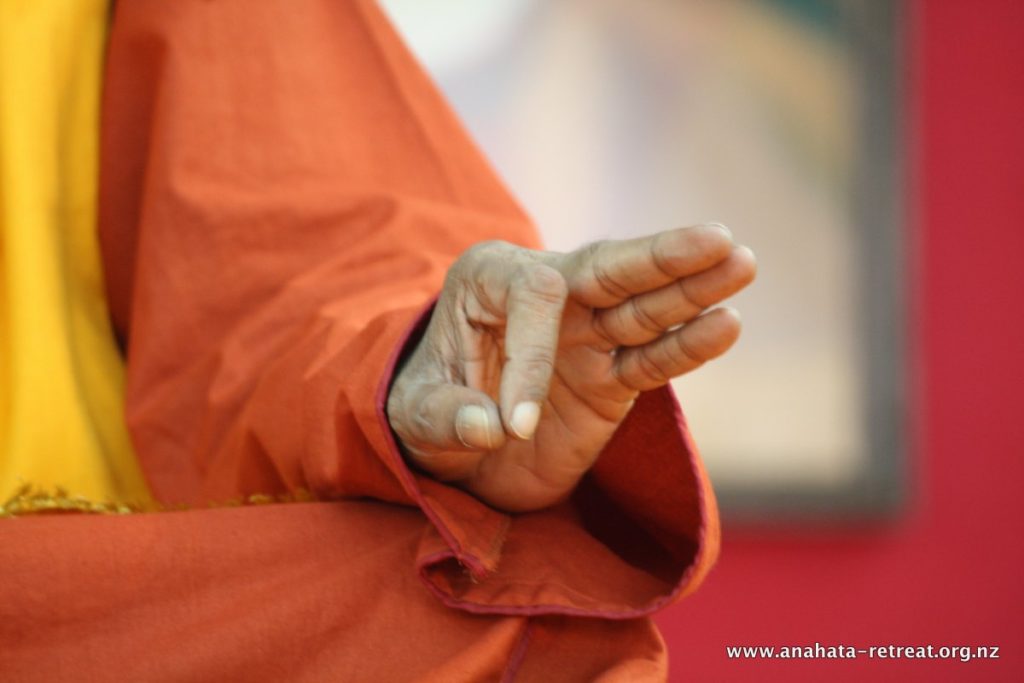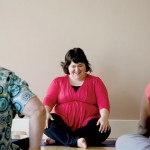
by Swami Karma Karuna, Anahata Yoga Retreat
Whether consciously or unconsciously, the way we gesture or carry ourselves in physical attitudes throughout the day has the capacity to influence health, interactions, physiology and more. Using the body to express something or to communicate a feeling underlies many of our interactions in an unspoken way. Mudras, the ancient science of creating gestures with the hands, head or whole body, is a powerful and subtle yogic practice that is often overlooked.
The word mudra is generally translated as ‘seal’, ‘gesture’ or ‘attitude’ and can be described as psychic, emotional, devotional and aesthetic gestures or stances. Mudras are a combination of refined physical positions that have the capacity to alter perception, to deepen awareness or to enhance concentration, as well as offering many other therapeutic benefits.
Body Language and Mudras
Human experience is reflected in the position of the body, the expression on the face and the way in which we move. For example, during pain, there is an intuitive, reactive response, and the automatic gesture or grimace reflects that emotion. Body language reflects the constant communication that occurs between the physical body and the other layers of experience such as the mental and emotional states. Similarly, mudras reflect an inner state of meditative experience or flow of vital energy.
From time immemorial, body language has aided in communication. Research by Mehrabian surmised that in face-to-face communication, body language conveys 55% of the overall message. How we walk or hold our body can reflect what is going on internally. In turn, the way we hold our body influences physiology, which alters our internal experience. Consider crossing the arms, which constricts the chest, alters the breathing patterns influencing the heart rate and the release of certain hormones, and so the cycle goes.
In daily life, we may be unaware of the power of body language. However, when we intentionally position the body with mindfulness and for a specific purpose, as with the science of mudras, it becomes a transformative practice. This can help us to consciously alter our mood, attitude and perception. Mudras can also be interpreted as symbols to express an inner experience or to aid to developing that inner experience by holding an external attitude.
Mudras and Acupuncture
As in many areas of yoga, parallels with other spiritual and cultural traditions abound. The Meridians used in acupuncture and the yogic concept of Nadis or vital flows of energy are both considered similar to fuel lines running through the body, distributing vital energy to sustain the body and mind. When the flow is unimpeded and balanced, there is health in the organs and body systems. When there is a block or imbalanced flow, then dis-ease pervades.
Mudras influence these subtle fuel lines as well as help to conserve the energy by directing the senses in particular ways. Through the overuse of the five senses, as well as the intake of stimuli and impressions during unconscious activity, the vital energy can become depleted. This is a primary factor in some of the modern imbalances and illnesses we face as a society.
One of the important aims of mudras is to create closed circuits of energy, which allow the practitioner to redirect that energy. For example, when certain fingers are consciously brought together, then that energy that would normally be dissipated through the hands is redirected. Not only does this provide many therapeutic benefits, it is also beneficial for awakening higher states of meditation.
Mudras and the Brain
It is important to have some understanding of the link between the brain and the body to fully grasp the power of mudra.
Much of our human experience is at an autonomic level, such as the breath, digestion, sleep and temperature changes. Even emotional responses occur at the automatic level through the limbic system, often called the emotional or primitive brain.
The cortex is considered the higher brain and gives depth and meaning to signals from the senses. When the cortex is engaged, thoughts, understanding and meaning are given to the sensations. We are no longer only in the realm of automatic response, but in the area of higher functioning. When the cortex links to the primitive brain, it brings what is normally unconscious and instinctual to the conscious awareness.
One aim of mudras is to create fixed, repetitive gestures. These have the capacity to alter and refine the instinctual, habitual behaviors as well as establish a subtle influence over these unconscious patterns and areas.
Process of Mudra and Brain Interaction:
- Neural impulses are first generated in the brain itself ie. a thought creates the impulses
- A command is sent from the motor cortex down a neural pathway to the areas involved in the mudra
- The mudra is performed
- Contraction of related muscles and mental concentration creates neural impulses
- Impulses are sent back through sensorial neural tracts to the cortex
- With the cortex engaged, effort to maintain the mudra triggers new impulses from the brain towards the periphery
- This creates a loop or circular pattern
- The repeating pattern builds the energy through the neural circuit
- When a sufficient quantum of prana circulates, neural circuits are modified and new areas of the brain are activated and brought into the realm of consciousness
With regular practice of mudra, there is potential for dormant areas of the brain to be activated, come under conscious awareness and become balanced. During this process, the samskaras, subconscious mental patterns. and impressions are brought to the surface and purified. The samskaras “lock” our mind and body into patterned responses, limiting us and compelling us to act in certain ways. They also keep us attached to the past or projecting into the future.
When the patterns are released through the process of mudra or other yoga practices, the energy becomes free and can be redirected into creativity, learning new skills and awakening higher states of consciousness through meditation.
Mudras begin with the physical body, influence the pranic body and then, directly or indirectly, influence the mind. They are powerful yet subtle tools which allow us to control subconscious layers of experience, conserve vital energy and support transformation on the path of yoga.
References:
Saraswati S. Mudra Vigyan. Bihar School of Yoga, Munger, Bihar, India, 2013.
Saraswati, S. Mudras and States of Awareness, http://www.yogamag.net/archives/2002/bmar02/mudras.shtml
Debenham L. Communication-What Percentage is Body Language, 2016, http://www.bodylanguageexpert.co.uk/communication-what-percentage-body-language.html
About Swami Karma Karuna

Swami Karma Karuna is an engaging, intuitive yoga and meditation teacher, inspirational speaker, writer and IAYT certified Yoga Therapist with more than 25 years of experience. She is trained in the traditional Bihar Yoga system, is a senior teacher of Yoga Australia/New Zealand and a director of Anahata Yoga Retreat, New Zealand. Swami Karma Karuna travels throughout the world, leading yoga events and training yoga teachers with an authentic and down to earth approach, weaving together the ancient practices with a touch of psychology and brain science aimed at motivating students to live their yoga here and now.
Website: www.anahata-retreat.org.nz
Facebook: Karma Karuna Saraswati
Video Link: https://www.youtube.com/watch?v=DSsQ-Xtz5tE

Well written, easy to understand and very informative! Thank you for enlightening us in such a professional way! The ultimate aim of the Yoga is enlightenment,It is believed that liberation could be more quickly achieved through a sophisticated set of transformation practices designed to purify the physical body and mind through energy practices.
Very nice and inspiring post!